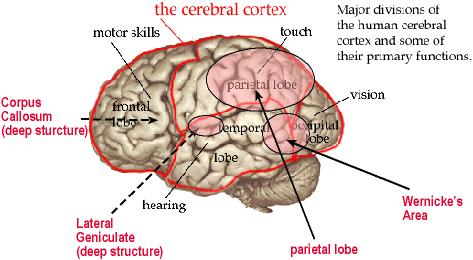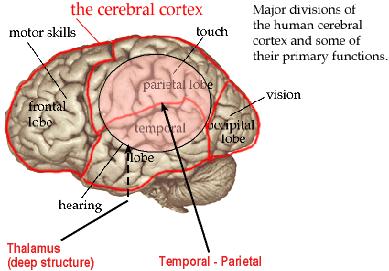| ESE424 : The Class : Mild Disabilities : Learning disability : Causes | |||||
Causes and Treatment
Causes of a Learning Disability
Although we have known about learning disabilities for many years, there is little consensus about the specific causes of this disorder. Initially, most doctors and professionals in the field of special education felt that learning disabilities were biologically based, dysfunctions in the structure or function of the brain. Later, researchers focused in environmental or teaching variables. With the advent of more precise brain imaging technology, there has been a renewed interest in studying the brain for potential reasons for some of the characteristics we see with children and adults who have learning disabilities.
Current research in education, medicine, psychology, and mental health have uncovered many potential explanations, but none appears to be primary. As with mental retardation, it is likely that learning disabilities may stem from many factors, interrelated in complex and subtle ways. In this online lesson we will look at potential medical and environmental factors that have been related to learning disabilities. These include:
- Abnormalities in brain structure and function
- Altered levels of blood flow, glucose metabolism
- Environmental factors such as alcohol, and toxins
- Patterns of inheritance with learning disabilities
To begin our discussion, visit the site below for a brief overview of some of the potential causes of a learning disability.
What Causes a Learning Disability?
Brain Structure

If you recall, one of the most prominent parts of the various definitions of a learning disability is the assumption of some form of central nervous system dysfunction. This is represented by the concept of processing problems (for review, see Understanding Processing Defiicts) that must be documented in the evaluation process. The implicit assumption is that there is something different about either the structure or function of the brain of children and adults with learning disabilities.
To begin, you should review some information about the normal structure and fuction of the brain and the potential problems that could result if certain areas of the brain are not functioning properly. I am going to send you to a site that reviews this information briefly and thoroughly. Although the site is concerned with traumatic brain injury (TBI), the information is equally relevant to our discussion of the structure and function of the brain of persons with learning disabilities.
Recent medical research has uncovered a variety of structural differences in the brains of children and adults with learning disabilities. Because reading is the most commonly effected area for children with a learning disability, research on structural differences has focused on this area of learning disabilities.
When you read, your eyes pass over the written or visual image sending signals to the occipital cortex through the visual tracts. The information is processed and sent to a portion of the left temporal lobe (the angular gyrus) and Werneke's area (a language area of the brain). The interepretation of the visual information occurs in the left temporal lobe in most persons. Also, in most persons, the left temporal lobe is slightly larger than the right.
Studies of the morphology (structure and form) of the brain of children and adults with learning disabilities have generated some interesting results, including:
- areas of the right and left temporal lobes are approximately the same size (none of the typical assymetry)
- the corpus callosum (responsible for communication between the two hemispheres) is slightly smaller and less developed than in comparison peers.
- microscopic differences in the parietal lobe of the brain (auditory processing and syntax) and in the lateral geniculate (sensitive to visual processing of visual information). Both areas show displacements of cells and developmental malformations that effect the normal arrangement of cells.

Definition of a Learning Dysfunction
Researchers Map Physical Basis of Dyslexia
Dyslexia and Language Brain Areas
Dysfunctional Network in Brain's Left Hemisphere Linked to Dyslexia
Brain Function
A second area of research has found differences in the function of the brain for certain children with learning disabilities. Some of the specific areas that have been associated with learning disabilities are blood flow and glucose use. In both instances, these functions have been found to be significantly different for some children with learning disabilities.
Research on brain function has shown that children with a learning disability may
- have decreased activation of the left temporal-parietal lobes
- dysfunction of the central neural pathways that carry information within the brain
- abnormalities in the thalamus (attention and planning)

Visit these sites for more detailed information about the differences in brain function between persons with a learning disability and comparison peers.
Brain Damage Detected in Children with Attention Deficit Disorder and Learning Disabilities
Environmental Factors
The child's environment may also have a strong influence on learning disabilities. Various researhers have been sarching for substances that may interrupt or disrupt the learning process. Specific substances that have been implicated with these interruptions or disruptions are lead and reactions to certain dietary substances (allergies). As with brain structure and function, the results of these studies can only be viewed as correlative, not causative.

Environmental Causes of a Learning Disability
Genetic Influence
In addition to the information we are accumulating about the brain structure and function of persons with learning disabilties, we have long known that, at least in some instances, this condition occurrs across generations of families. Decker and Defies (1980) found higher incidence of reading difficulties in families where the parents or a sibling had a reading disability. Other researchers have found recurrence rates (the number of times learning disabilities reappear in families) varying between 38% to a high of 43%. Lastly, studies of fraternal and identical twins have shown that the rates of reading and learning disabilities are quite high. For example, Hermann (1959) found that of the 12 pairs of identical twins he studied, all members of the twin sets had reading difficulties.
Visit these sites for additional information about learning disabilities and inheritance.
Genetic Learning Disability Patterns in Family Literacy
Colorado Twin Study and Reading Disability
Treatment and Intervention
Since this is not a methods course, we will only briefly touch on treatment and intervention information. In this course, that will consist of sending you to sites that have compiled information about basic strategies for working with and educating children with learning disabilties. The first site contains an article that will provide you with an overview of many topics. After this I have listed several sites that will present additional information on this topic.
Overview of Effective Interventions
Strategies to assist teachers:
Strategies for persons with learning disabilities
Once you have finished you should:
Go on to Case
Study
or
Go back to Learning
Disabilities
E-mail Larry Gallagher at Larry.Gallagher@nau.edu
Copyright © 2000 Northern Arizona
University
ALL RIGHTS RESERVED